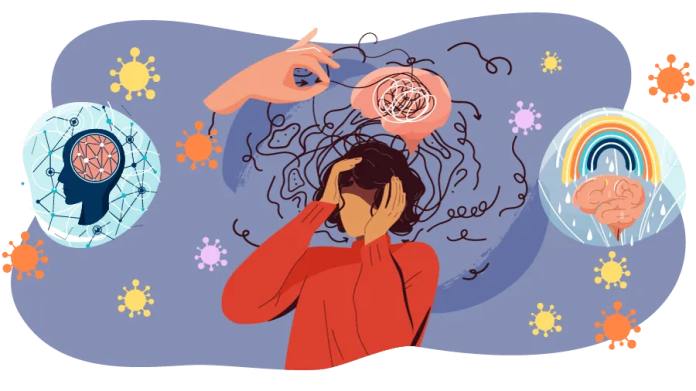Anxiety and depression are two of the most common mental health conditions affecting people worldwide. While they are distinct disorders, they often coexist and share many similarities. In this comprehensive guide, we will explore the nature of anxiety and depression, their causes, symptoms, and effective strategies for managing and seeking help when needed.
Anxiety
What is Anxiety?
Anxiety is a natural response to stress and danger. It can be adaptive, helping us stay alert and focused. However, when anxiety becomes chronic or excessive, it can lead to an anxiety disorder.
Types of Anxiety Disorders
Anxiety disorders encompass a range of conditions characterized by excessive and often irrational worry or fear. These disorders can significantly impact a person’s daily life and well-being. Understanding the different types of anxiety disorders is crucial for effective diagnosis and treatment.
Generalized Anxiety Disorder (GAD)
Generalized Anxiety Disorder, or GAD, is characterized by persistent and excessive worry about various aspects of life, even when there is little or no reason for concern. People with GAD often find it challenging to control their anxiety and may experience physical symptoms like muscle tension and restlessness.
Panic Disorder
Panic Disorder is marked by recurring, unexpected panic attacks. These attacks are intense episodes of fear and discomfort and can include symptoms such as rapid heartbeat, shortness of breath, and a sense of impending doom.
Social Anxiety Disorder
Social Anxiety Disorder, also known as social phobia, involves an overwhelming fear of social situations and scrutiny by others. Individuals with this disorder often avoid social gatherings and may experience extreme self-consciousness in public.
Specific Phobias
Specific Phobias are characterized by intense and irrational fears of specific objects or situations. Common examples include fear of flying, heights, or spiders. These phobias can lead to avoidance behaviors.
Obsessive-Compulsive Disorder (OCD)
Obsessive-Compulsive Disorder involves recurrent and distressing obsessions (intrusive, unwanted thoughts) and compulsions (repetitive behaviors) performed to alleviate anxiety. OCD can significantly disrupt daily life.
Post-Traumatic Stress Disorder (PTSD)
Post-Traumatic Stress Disorder can develop after exposure to a traumatic event. Symptoms may include intrusive memories, nightmares, hypervigilance, and emotional numbness.
Common Symptoms of Anxiety
Anxiety can manifest in various ways, and its symptoms can vary from person to person. Common symptoms of anxiety include:
- Excessive worry or fear
- Restlessness or nervousness
- Muscle tension
- Rapid heartbeat
- Sweating or trembling
- Irritability
- Difficulty concentrating
- Sleep disturbances
Causes of Anxiety
Anxiety disorders have multiple potential causes, including:
Genetic predisposition
A family history of anxiety can increase one’s risk.
Brain chemistry
Imbalances in neurotransmitters can contribute to anxiety.
Trauma or stressful life events
Past traumatic experiences or ongoing stressors can trigger anxiety.
Chronic medical conditions
Certain health conditions can be associated with anxiety symptoms.
Substance abuse
Alcohol or drug misuse can exacerbate or cause anxiety.
Treatment for Anxiety
Fortunately, anxiety disorders are highly treatable. Effective treatments include:
Psychotherapy (Cognitive Behavioral Therapy, Exposure Therapy)
Psychotherapy, particularly Cognitive Behavioral Therapy (CBT), which helps individuals identify and manage anxious thoughts and behaviors.
Medications (Antidepressants, Benzodiazepines)
Medications, such as antidepressants or anti-anxiety drugs, are prescribed by a healthcare professional.
Lifestyle changes
Lifestyle changes include stress management techniques, regular exercise, and a balanced diet.
Depression
What is Depression?
Depression is a mood disorder characterized by persistent feelings of sadness, hopelessness, and a lack of interest or pleasure in activities. It can significantly impact daily life.
Types of Depression
Depression encompasses various forms of mood disorders. Understanding these types is crucial for proper diagnosis and treatment.
Major Depressive Disorder (MDD)
Major Depressive Disorder, or MDD, is characterized by persistent feelings of sadness, hopelessness, and a lack of interest or pleasure in daily activities. It often disrupts daily life and can lead to physical symptoms.
Persistent Depressive Disorder (Dysthymia)
Persistent Depressive Disorder, also known as Dysthymia, involves chronic, low-grade depression that lasts for two years or more. It may have fewer symptoms than MDD but can be long-lasting.
Bipolar Disorder (Manic-Depressive Illness)
Bipolar Disorder, previously called Manic-Depressive Illness, involves alternating periods of depression and mania. Manic episodes are marked by elevated mood, increased energy, and risky behavior.
Common Symptoms of Depression
Depression can manifest in various ways, but common symptoms include:
- Persistent sadness or emptiness
- Loss of interest or pleasure in activities
- Fatigue or low-energy
- Changes in appetite or weight
- Sleep disturbances (insomnia or hypersomnia)
- Feelings of guilt or worthlessness
- Difficulty concentrating or making decisions
- Suicidal thoughts or behaviors
Causes of Depression
Depression can result from a combination of factors, including:
- Genetic predisposition: Family history may increase susceptibility.
- Brain chemistry: Imbalances in neurotransmitters, like serotonin and dopamine, can play a role.
- Trauma or loss: Personal trauma or significant life changes can trigger depressive episodes.
- Chronic illnesses: Some medical conditions, such as chronic pain or cancer, can contribute to depression.
- Medications or substance abuse: Certain drugs or alcohol misuse can lead to depressive symptoms.
Treatment for Depression
Effective treatments for depression include:
- Psychotherapy (Cognitive Behavioral Therapy, Interpersonal Therapy)
- Medications (Antidepressants)
- Electroconvulsive Therapy (ECT) in severe cases
- Lifestyle changes (Exercise, Diet, Sleep)
Strategies for Managing Anxiety and Depression
Seeking Professional Help
Recognizing the signs and seeking help from mental health professionals is essential. Therapy and medication can be highly effective in managing symptoms.
Self-Care Practices
- Regular exercise
- Healthy diet
- Adequate sleep
- Stress management techniques (e.g., meditation, deep breathing)
- Avoiding alcohol and drug abuse
Support Systems
Maintaining healthy relationships and seeking support from friends and family can provide a strong emotional foundation.
Mindfulness and Relaxation
Mindfulness practices, such as meditation and yoga, can help individuals manage stress and reduce symptoms of anxiety and depression.
Setting Realistic Goals
Breaking tasks into smaller, manageable steps can reduce feelings of overwhelm and improve motivation.
Final Thoughts
Anxiety and depression are complex mental health conditions that can affect anyone. It’s essential to recognize that seeking help is a sign of strength, not weakness. Effective treatments are available, and recovery is possible.
If you or someone you know is struggling with anxiety or depression, reach out to a mental health professional for guidance and support. With the right resources and strategies, it is possible to manage these conditions and regain a fulfilling and meaningful life.






